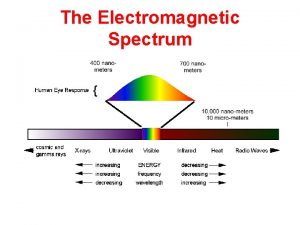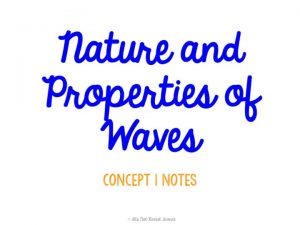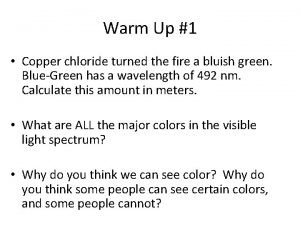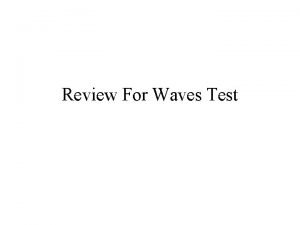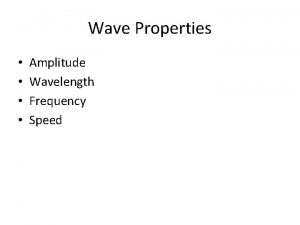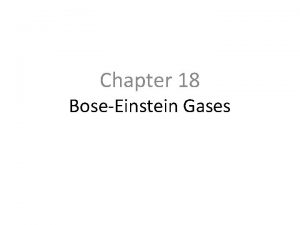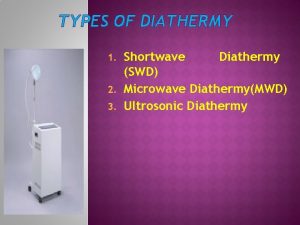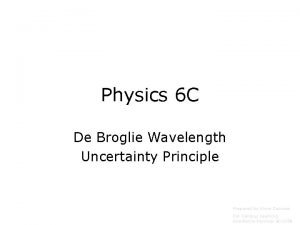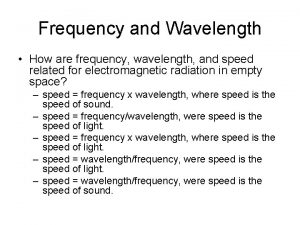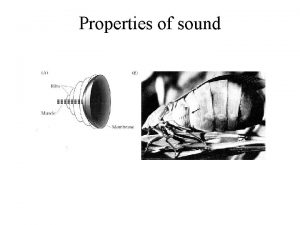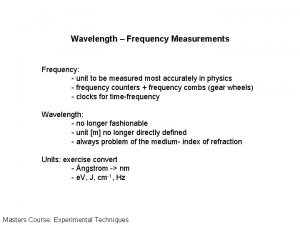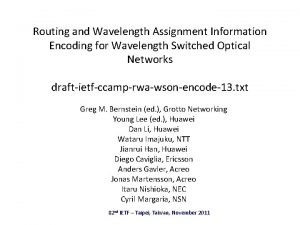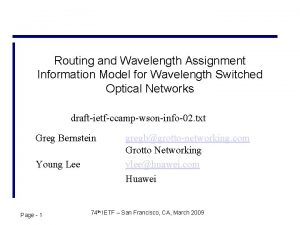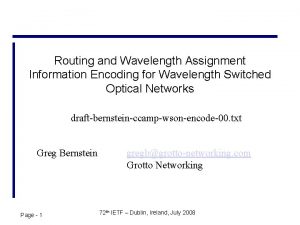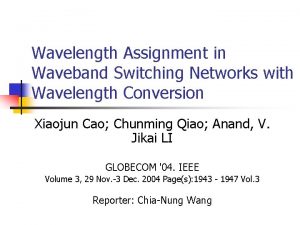Example 7 1 Wavelength and Frequency Calculate the













- Slides: 13

Example 7. 1 Wavelength and Frequency Calculate the wavelength (in nm) of the red light emitted by a barcode scanner hat has a frequency of 4. 62 × 1014 s – 1. Solution You are given the frequency of the light and asked to find its wavelength. Use Equation 7. 1, which relates frequency to wavelength. You can convert the wavelength from meters to nanometers by using the conversion factor between the two (1 nm = 10 – 9 m). For Practice 7. 1 A laser dazzles the audience in a rock concert by emitting green light with a wavelength of 515 nm. Calculate the frequency of the light. Chemistry: A Molecular Approach, 4 th Edition Nivaldo J. Tro © 2017 Pearson Education, Inc.

Example 7. 2 Photon Energy A nitrogen gas laser pulse with a wavelength of 337 nm contains 3. 83 m. J of energy. How many photons does it contain? Sort You are given the wavelength and total energy of a light pulse and asked to find the number of photons it contains. Given: Epulse = 3. 83 m. J λ = 337 nm Find: number of photons Strategize In the first part of the conceptual plan, calculate the energy of an individual photon from its wavelength. In the second part, divide the total energy of the pulse by the energy of a photon to determine the number of photons in the pulse. Conceptual Plan Chemistry: A Molecular Approach, 4 th Edition Nivaldo J. Tro © 2017 Pearson Education, Inc.

Example 7. 2 Photon Energy Continued Relationships Used E = hc/λ (Equation 7. 3) Solve To execute the first part of the conceptual plan, convert the wavelength to meters and substitute it into the equation to calculate the energy of a 337 -nm photon. To execute the second part of the conceptual plan, convert the energy of the pulse from m. J to J. Then divide the energy of the pulse by the energy of a photon to obtain the number of photons. Solution Chemistry: A Molecular Approach, 4 th Edition Nivaldo J. Tro © 2017 Pearson Education, Inc.

Example 7. 2 Photon Energy Continued Check The units of the answer, photons, are correct. The magnitude of the answer (1015) is reasonable. Photons are small particles, and any macroscopic collection must contain a large number of them. For Practice 7. 2 A 100 -watt lightbulb radiates energy at a rate of 100 J/s. (The watt, a unit of power, or energy over time, is defined as 1 J/s. ) If all of the light emitted has a wavelength of 525 nm, how many photons are emitted per second? (Assume three significant figures in this calculation. ) For More Practice 7. 2 The energy required to dislodge electrons from sodium metal via the photoelectric effect is 275 k. J/mol. What wavelength in nm of light has sufficient energy per photon to dislodge an electron from the surface of sodium? Chemistry: A Molecular Approach, 4 th Edition Nivaldo J. Tro © 2017 Pearson Education, Inc.

Example 7. 3 Wavelength, Energy, and Frequency Arrange these three types of electromagnetic radiation—visible light, X-rays, and microwaves—in order of increasing a. wavelength. b. frequency. c. energy per photon. Solution Examine Figure 7. 5 and note that X-rays have the shortest wavelength, followed by visible light and then microwaves. a. wavelength X-rays < visible < microwaves Since frequency and wavelength are inversely proportional—the longer the wavelength, the shorter the frequency —the ordering with respect to frequency is the reverse of the ordering with respect to wavelength. b. frequency microwaves < visible < X-rays Energy per photon decreases with increasing wavelength but increases with increasing frequency; therefore, the ordering with respect to energy per photon is the same as for frequency. c. energy per photon microwaves < visible < X-rays For Practice 7. 3 Arrange these three colors of visible light—green, red, and blue—in order of increasing a. wavelength. b. frequency. c. energy per photon. Chemistry: A Molecular Approach, 4 th Edition Nivaldo J. Tro © 2017 Pearson Education, Inc.

Example 7. 4 De Broglie Wavelength Calculate the wavelength of an electron traveling with a speed of 2. 65 × 106 m/s. Sort You are given the speed of an electron and asked to calculate its wavelength. Given: v = 2. 65 × 106 m/s Find: λ Strategize The conceptual plan shows how the de Broglie relation relates the wavelength of an electron to its mass and velocity. Conceptual Plan Relationships Used λ = h/mv (de Broglie relation, Equation 7. 4) Solve Substitute the velocity, Planck’s constant, and the mass of an electron into Equation 7. 4 to calculate the electron’s wavelength. To correctly cancel the units, break down the J in Planck’s constant into its SI base units (1 J = 1 kg · m 2/s 2). Chemistry: A Molecular Approach, 4 th Edition Nivaldo J. Tro © 2017 Pearson Education, Inc.

Example 7. 4 De Broglie Wavelength Continued Solution Check The units of the answer (m) are correct. The magnitude of the answer is very small, as expected for the wavelength of an electron. For Practice 7. 4 What is the velocity of an electron that has a de Broglie wavelength approximately the length of a chemical bond? Assume the length of a chemical bond is 1. 2 × 10 – 10 m. Chemistry: A Molecular Approach, 4 th Edition Nivaldo J. Tro © 2017 Pearson Education, Inc.

Example 7. 5 Quantum Numbers I What are the quantum numbers and names (for example, 2 s, 2 p) of the orbitals in the n = 4 principal level? How many n = 4 orbitals exist? Solution First, determine the possible values of l (from the given value of n). For a given value of n, the possible values of l are 0, 1, 2, . . . , (n – 1). n = 4; therefore, l = 0, 1, 2, and 3 Next, determine the possible values of ml for each value of l. For a given value of l, the possible values of ml are the integer values, including zero, ranging from –l to +l. The name of an orbital is its principal quantum number (n) followed by the letter corresponding to the value l. The total number of orbitals is given by n 2. For Practice 7. 5 List the quantum numbers associated with all of the 5 d orbitals. How many 5 d orbitals exist? Chemistry: A Molecular Approach, 4 th Edition Nivaldo J. Tro © 2017 Pearson Education, Inc.

Example 7. 6 Quantum Numbers II These sets of quantum numbers are each supposed to specify an orbital. One set, however, is erroneous. Which one and why? a. n = 3; l = 0; ml = 0 c. n = 1; l = 0; ml = 0 b. n = 2; l = 1; ml = – 1 d. n = 4; l = 1; ml = – 2 Solution Choice d. is erroneous because for l = 1, the possible values of ml are only – 1, 0, and +1. For Practice 7. 6 Each set of quantum numbers is supposed to specify an orbital. However, each set contains one quantum number that is not allowed. Replace the quantum number that is not allowed with one that is allowed. a. n = 3; l = 3; ml = +2 c. n = 1; l = 1; ml = 0 Chemistry: A Molecular Approach, 4 th Edition Nivaldo J. Tro b. n = 2; l = 1; ml = – 2 © 2017 Pearson Education, Inc.

Example 7. 7 Wavelength of Light for a Transition in the Hydrogen Atom Determine the wavelength of light emitted when an electron in a hydrogen atom makes a transition from an orbital in n = 6 to an orbital in n = 5. Sort You are given the energy levels of an atomic transition and asked to find the wavelength of emitted light. Given: n = 6 → n = 5 Find: λ Strategize In the first part of the conceptual plan, calculate the energy of the electron in the n = 6 and n = 5 orbitals using Equation 7. 7 and subtract to find ΔEatom. In the second part, find Ephoton by taking the negative of ΔEatom and then calculate the wavelength corresponding to a photon of this energy using Equation 7. 3. (The difference in sign between Ephoton and ΔEatom applies only to emission. The energy of a photon must always be positive. ) Conceptual Plan Chemistry: A Molecular Approach, 4 th Edition Nivaldo J. Tro © 2017 Pearson Education, Inc.

Example 7. 7 Wavelength of Light for a Transition in the Hydrogen Atom Continued Relationships Used En = – 2. 18 × 10– 18 J(1/n 2) E = hc/λ Solve Follow the conceptual plan. Begin by calculating ΔEatom. Calculate Ephoton by changing the sign of ΔEatom. Solve the equation relating the energy of a photon to its wavelength for λ. Substitute the energy of the photon and calculate λ. Solution Chemistry: A Molecular Approach, 4 th Edition Nivaldo J. Tro © 2017 Pearson Education, Inc.

Example 7. 7 Wavelength of Light for a Transition in the Hydrogen Atom Continued Ephoton = – ΔEatom = +2. 6644 × 10– 20 J Check The units of the answer (m) are correct for wavelength. The magnitude is reasonable because 10– 6 m is in the infrared region of the electromagnetic spectrum. You know that transitions from n = 3 or n = 4 to n = 2 lie in the visible region, so it makes sense that a transition between levels of higher n value (which are energetically closer to one another) results in light of longer wavelength. For Practice 7. 7 Determine the wavelength of the light absorbed when an electron in a hydrogen atom makes a transition from an orbital in the n = 2 level to an orbital in the n = 7 level. Chemistry: A Molecular Approach, 4 th Edition Nivaldo J. Tro © 2017 Pearson Education, Inc.

Example 7. 7 Wavelength of Light for a Transition in the Hydrogen Atom Continued For More Practice 7. 7 An electron in the n = 6 level of the hydrogen atom relaxes to a lower-energy level, emitting light of λ = 93. 8 nm. Find the principal level to which the electron relaxed. Chemistry: A Molecular Approach, 4 th Edition Nivaldo J. Tro © 2017 Pearson Education, Inc.
 Longest wavelength in electromagnetic spectrum
Longest wavelength in electromagnetic spectrum Amplitude wavelength and frequency
Amplitude wavelength and frequency A rhythmic disturbance that transfers energy
A rhythmic disturbance that transfers energy Frequency wavelength relation
Frequency wavelength relation Relation between frequency and wavelength
Relation between frequency and wavelength Wavelength frequency
Wavelength frequency How to find wavelength from frequency
How to find wavelength from frequency Transverse wave and longitudinal wave example
Transverse wave and longitudinal wave example Frequency equation wavelength
Frequency equation wavelength Frequency formula in terms of wavelength
Frequency formula in terms of wavelength Difference between swd and mwd
Difference between swd and mwd Frequency spectrum
Frequency spectrum Wavelength intensity formula
Wavelength intensity formula How to calculate wavelength
How to calculate wavelength
